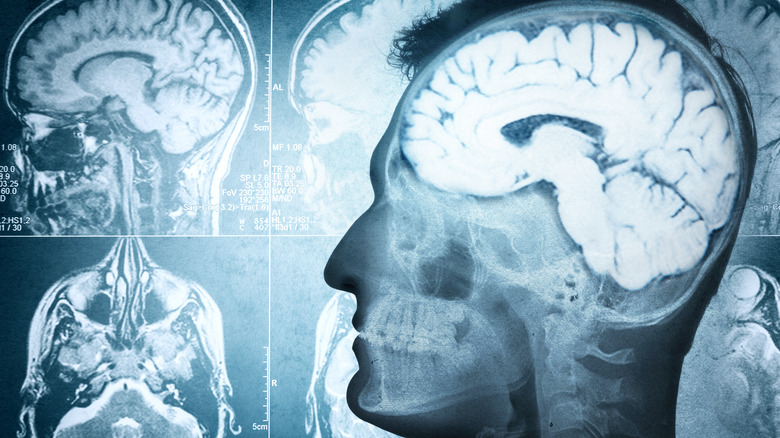Surprising Things That Actually Happen To The Male Body
We may receive a commission on purchases made from links.
When it comes to the differences between males and females, leaving the toilet seat up is the least of it. Men may not really be from Mars, but in many ways, their bodies are different enough from women's bodies that they might as well belong to aliens. The male body is capable of some truly remarkable (and sometimes shocking) things.
While there may be a lot of biological differences between men and women, the male body is an extraordinary and mysterious thing and it is full of surprises. Men also share some shocking similarities with women that most people probably have no idea about. Even a lot of men are quite likely unaware of many of these incredibly surprising facts about the male body. Keep reading to learn things about the male body that were probably not covered in your high school anatomy class. Don't be nervous, though — there won't be a test.
Lactation is possible under extreme circumstances
If you think that lactation is solely a woman's domain, we don't blame you. After all, breastfeeding is most commonly associated with pregnancy and motherhood. It turns out, though, that men can also lactate — although it is far from a common occurrence. While it has been claimed that any man can induce lactation through nipple stimulation, breastfeeding expert and doctor Jack Newman told Scientific American that it's a bit more complicated than that.
According to Newman, lactation in men can only occur through a hormone spike, possibly caused by a pituitary tumor or as a side effect of medication. Such conditions can increase the production of prolactin, the hormone that is needed to produce milk. It's not just human males who can lactate, either. Males of other mammalian species have been observed lactating, although, fun fact, male lactation only occurs naturally among the Dayak fruit bats of Southeast Asia.
They can get yeast infections
Yeast infections are another thing that we typically think of as occurring only in females. Unfortunately, men can also get yeast infections and it is just as unpleasant for them as it is for women. One common way that men can contract a yeast infection is by having sex with someone who has an infection, but they can also develop them through poor hygiene.
In men, yeast infections can also lead to an uncomfortable condition called balanitis, which causes the head of the penis to inflame. Symptoms include a white substance gathering in the folds of the skin of the penis, areas of shiny, white skin, and an itching or burning sensation. Balanitis is more common in men who are uncircumcised or are overweight, and those who have pre-existing health conditions such as diabetes or HIV. Using antibiotics for a prolonged period can also increase the chances of developing balanitis.
Dads can suffer from postpartum depression
Pregnancy and childbirth are difficult for anyone to go through, but for some women the aftermath can be even harder. Postpartum depression can last for several weeks or longer, and may be characterized by feelings of anxiety, panic attacks, loss of interest in activities, decreased appetite, and withdrawing from family and friends. One in seven mothers experience postpartum depression, but men can suffer from it too. The condition is more common in young fathers, those going through relationship or financial problems, and those with a history of depression. While their symptoms can be the same as women, in men the condition is called paternal postpartum depression.
According to a report in the Journal of the American Medical Association (via Parents.com), 10 percent of men experience paternal postpartum depression, which can begin in the first trimester of their partner's pregnancy. The depression may even continue for six months after the birth. The number of men suffering from paternal postpartum depression increases to 26 percent in the three to six months after the baby's birth.
Men aren't as good at seeing colors
If your husband couldn't care less about picking out paint colors for your living room, there could be a scientific reason for it. Men and women actually see colors differently. A study led by Israel Abramov, a psychology professor at Brooklyn College, found that women are better able to distinguish between various shades of blues, greens, and yellows. "Across most of the visible spectrum males require a slightly longer wavelength than do females in order to experience the same hue," said Abramov's research team in Biology of Sex Differences.
Warmer colors have longer wavelengths, which means that a woman seeing an orange will see a truer orange color, while men will see more of a reddish hue. Grass also appears greener to women, while men see a bit more of a yellow tinge. It's not all bad news for men, though. They might not see colors as well as women do, but they are better at seeing details from a far distance, as well as tracking quickly moving objects.
They have anti-aging powers... sort of
On average, women have a longer life expectancy than men. While it might seem like men are getting the short end of the stick, nature has blessed them with a more youthful appearance. Since men tend to have higher testosterone levels, their skin is roughly 25 percent thicker than women's skin. They also have more collagen density, along with skin that is more moist because they sweat more. Men also lose collagen more gradually than women, who experience about five years of rapid collagen loss after menopause.
This means that male skin doesn't show signs of aging as much as female skin does. This doesn't mean that they can get away with not caring for their skin, though. Men might have the natural advantage, but women are far more likely to use products that protect their skin from the sun, which helps to slow down signs of aging.
They're less likely to have cellulite
Not only do men have skin that ages more slowly, but it is also less far likely to be marked by cellulite. Many women are self-conscious about those deposits of fat, even though cellulite is totally normal. Anyone can get it, but men are less susceptible than women; 90 percent of women have cellulite, compared to just 10 percent of men.
There are a couple reasons for this. The decrease of estrogen as a woman ages leads to decreased circulation, which leads to decreased collagen production, which in turn leads to cellulite. While even slim people can get cellulite, it is more likely to develop in people with more body fat. Since women tend to have more body fat than men, their chances of developing cellulite are greater. Men also have thicker bands connecting their skin and muscle, and it's arranged in a crisscross pattern. This holds fat in place better than the thinner, vertical bands that women have.
This is what the Adam's apple actually does
You probably know that men have Adam's apples, but do you know what the Adam's apple actually does? When boys' voices deepen during puberty, it's because they are developing a larger larynx. The larynx pushes against the throat as it grows, creating the bump we call the Adam's apple. A prominent Adam's apple is caused by a larger than average larynx, or more cartilage surrounding the vocal cords. While the Adam's apple itself doesn't actually do anything, the larynx is an important part of the body as it protects the vocal cords and keeps your voice in good health.
The reason that women don't usually have Adam's apples is the same reason that they typically have higher pitched voices than men. Their larynges usually don't grow large enough for an Adam's apple to form. There are, however, some women who experience more laryngeal growth than average and develop Adam's apples as they go through puberty.
They have larger brains
Hold up, hear us out — this doesn't mean what you might think. The human brain is a mysterious thing. For centuries, it was assumed that men were the superior sex and were more intelligent than their female counterparts. Modern science debunks this theory, however. Still, there some major differences between the male and female brain. For starters, men tend to have a higher total brain volume than women. This, however, doesn't mean that they are the more intelligent sex. Women usually have thicker cortices, which are linked to higher scores on intelligence tests.
That being said, neither of these things is enough to tip the balance over to either sex; men and women, on average, have no difference in intelligence, although they do tend to excel in different areas. Women outperform men, on average, when it comes to writing ability, reading comprehension, fine-motor coordination, and long-term memory. Men, on the other hand, are better at retrieving information from their working memory, and also have stronger visuospatial skills.
Some of them experience Irritable Male Syndrome
Menstruation has historically been viewed as a female-only curse. While men don't menstruate, many of them have an unpleasant "time of month" as well. They might not have to deal with tampons and pads, but many of them do experience what is called Irritable Male Syndrome. Studies have found that many men suffer from the same symptoms once a month as women going through PMS, including mood swings, being unable to focus, and physical discomfort.
A survey conducted by the U.K.'s VoucherCloud (via Medical Daily) found that a quarter of men experience these symptoms. While men may experience hormonal fluctuations, women don't have to worry about syncing up with their guy pals or their significant other. Women living together often find that their menstrual cycles sync up with each other so that they go through their time of month simultaneously, but this phenomenon seems to skip men.









